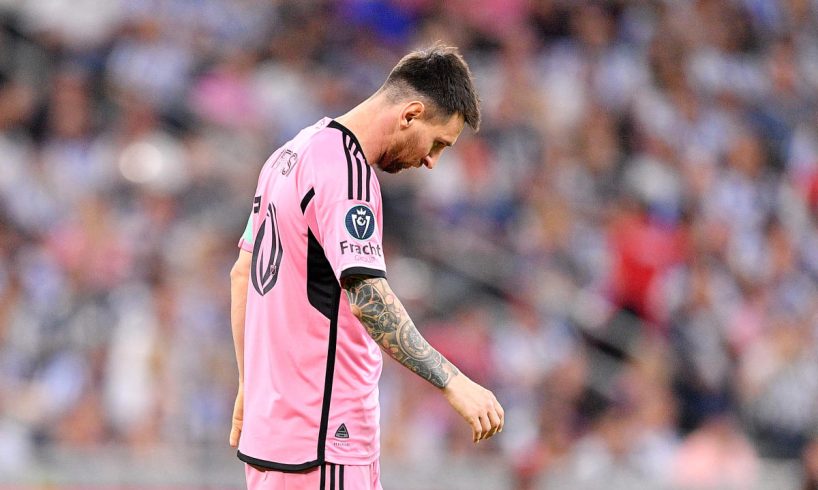
Lionel Messi and Co. fell to Liga MX’s Monterrey on Wednesday in Mexico and Major League Soccer’s structural inefficiencies were a key contributor. (Photo by Azael Rodriguez/Getty Images)
Major League Soccer has spent 10 months reveling in Lionel Messi-mania. It rolled out red carpets for the GOAT, then watched stadiums fill and business boom. It reveled in soaring revenues, in newfound relevance, in beaming spotlights. But on Wednesday night, those spotlights illuminated a damning, lingering truth that not even Messi could erase.
For all of MLS’ growth, for all its stated global ambition, it still lags on its own continent.
It lags behind the gigantes of Mexico’s Liga MX, just as Inter Miami lagged behind Monterrey in a telling CONCACAF Champions Cup quarterfinal. Messi and Miami lost to Rayados, 3-1 on Wednesday and 5-2 on aggregate. They were the sixth MLS team to fall to a Liga MX foe in the 2024 edition of North and Central America’s preeminent club competition. And they were proof of MLS’ most maddening sin. The league’s penny-pinchers have long hindered ambitious peers. Now, their hesitance has hamstrung Messi’s ability to elevate their league.
MLS, ever since its 1994 inception, has been playing catch-up. It is chasing more established leagues, and for years Mexico’s has been the first key benchmark. Early MLS teams were well below it. Recent ones had seemingly leveled up. The Champions Cup and its predecessor, the CONCACAF Champions League, became the primary proving ground. In 2022, the Seattle Sounders became the first MLS club to win the Champions League, and American soccer collectively hailed the triumph as proof of progress.
A couple years later, that Sounders run looks far more like a fluke.
From that high, in 2024, despite employing the greatest player ever, MLS has sunk to new CONCACAF depths.
Its teams have now played 14 matches vs. Liga MX in this year’s competition. They have lost nine, drawn five, won zero. They have scored 10 goals and conceded 33 — their worst such goal differential ever.
Made with Flourish
A revamped format granted them 10 spots in the 27-team tournament. Eight entered in the first knockout round; two received byes to the Round of 16. By the semifinals, only the Columbus Crew remain.
The Crew, bold and brave as ever, gutted out a 1-1 draw in Mexico on Tuesday, then beat Tigres on penalties. Elsewhere across the continent, over the past two months, a tiresome story reemerged. Pachuca pounded the Philadelphia Union, 6-0. Club América laughed off the New England Revolution, 9-2. Vancouver and Orlando lost to Tigres; Cincinnati and now Miami fell to Monterrey. And the common thread that binds those flops as one collective failure was painfully obvious.
While one league handicaps its own teams with reams of restrictions on spending and roster-building — restrictions designed to mitigate expensive mistakes, control costs and promote competitive balance domestically — the other doesn’t.
“Until MLS relaxes its many rules in order to build more robust squads, [so that] player absences, injuries, suspensions aren’t as difficult to overcome,” Inter Miami head coach Tata Martino said Wednesday, “evidently [Liga MX] will have an advantage.”
MLS growth hindered by structural inefficiencies
At nearly every level of professional soccer, spending correlates strongly with winning. Higher salaries attract better players; better players create better teams; duh. MLS understands this, and has gradually lifted some restrictions. Team payrolls have roughly tripled over the past decade.
But the teams aren’t thrice as good. They’ve improved, but for two fundamental reasons, the threefold salary increase is deceptive.
One: Everybody else is spending more, too. In the English Premier League, for example, wages have risen by similar amounts. Tigres and Monterrey are also spending more than they did a decade ago. TV contracts and commercial revenues have driven transfer-market inflation and wage growth throughout soccer. In relative terms, MLS clubs are gaining on international peers, but aren’t wildly outpacing them. With a few exceptions, they still spend significantly less than clubs at the top of Liga MX.
And two: they spend less efficiently. MLS rules don’t allow them to spread $21 million or $13 million across their roster responsibly. They can spend limitlessly on three Designated Players (DPs), and moderately beyond the salary cap on several more. Otherwise, they’re inhibited by the $5.47 million cap — so their rosters are top-heavy in what is widely considered a weak-link sport.
They can have Messi and Sergio Busquets. They can build a very strong starting 11. But once a few injuries strike, their cabinets become bare. Once momentum shifts, and a Liga MX opponent seizes control, as Monterrey did in Wednesday’s second half, Martino can look down Miami’s bench and not see a single sub worth putting into the game.
Monterrey and Club América can insert DP-level players.
“All the players we had on the bench were young players, we were not in a situation to use them,” Martino said postgame.
So nothing changed; and a rising Monterrey tide became a second goal, then a third, an insurmountable lead.
Martino has regularly cited the “restrictions” as a difference-maker vis-à-vis international competitors. He did so in Saudi Arabia in January. He did so again this month, and again Wednesday night, beating a drum that fellow MLS coaches and sporting directors have thumped for years.
They also cite their calendar. The Champions Cup is largely played February through April, aligning with the early stages of the MLS season, while the Liga MX Clausura — which begins in early January — is already in full swing. “We’ll play a game every three days when we’re not fully fit and in form,” New England head coach Caleb Porter said last week after a 4-0 first-leg loss to América.
But they know their primary disadvantage is self-imposed.
“As an MLS team in tournaments like this, if you want to consistently compete in finals and win these, you’re going to have to rethink your roster rules and regulations,” LAFC head coach Steve Cherundolo said after losing to Club León last June.
And that, for years, is what MLS team owners and executives have been doing. They’ve been thinking and rethinking, “really digging into the way in which our rosters are constructed, the way in which we put our budgets together,” as MLS vice president of player strategy Todd Durbin said this winter. They’ve been hiring consultants. They’ve been talking, listening, debating — and moving at a glacial pace.
‘We’re so slow-moving. It makes no sense’
MLS has taken tremendous strides since the early 2000s, enough to attract increasingly wealthy franchise owners, enough to lure Messi and friends to South Florida. It has built glistening stadiums and laid foundations. It has grown, in quantity and quality, with society’s economic winds at its back.
It was prepared, or so it seemed, to capitalize on Messi; to lift some spending restrictions; to seize the eyes of the world, show them quality soccer, and accelerate.
Instead, it idled.
The league will soon change several rules to allow for more (and more flexible) spending. Team owners, acting as the league’s board of governors, reportedly approved those changes Tuesday. They’ll likely take effect this summer. They’ll be hailed as important steps toward a rosy future.
But they’re baby steps, and tardy steps. “We’re so slow-moving. It makes no sense to me,” one MLS coach bemoaned to Yahoo Sports this offseason. Messi is nearly 37. The time to maximize him is now. The best chance to advertise him and all this growth to a global audience is the 2025 Club World Cup … and the last known chance for Inter Miami to qualify disappeared Wednesday.
So it is hard to escape the conclusion that MLS has failed Messi.
It is rising, milking and benefitting from his presence, yet failing to return the favor.
The counterargument, of course, is that blowing up a structure to accommodate a superstar is silly business. MLS isn’t beholden to Messi. The rich people who run it have refined their formula for steady growth. They believe it’s working.
But they keep falling short of their lofty goals. MLS commissioner Don Garber once said that by 2025, “people will think of us like Serie A, La Liga, and hopefully the way they think about the Premier League.” In 2024, they aren’t even close; and even a super-team carefully crafted around the GOAT can’t measure up to the best in Mexico.






